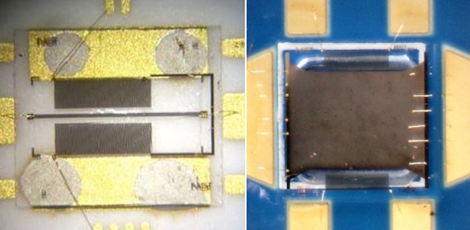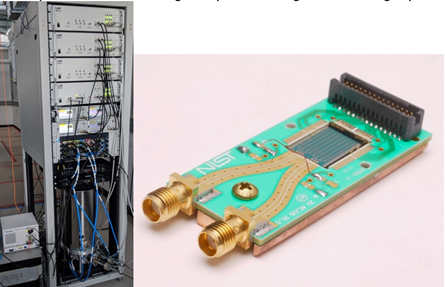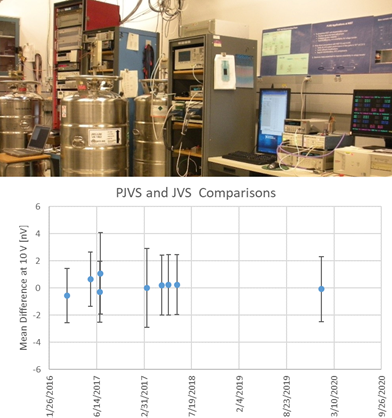Summary
The NIST Ac-dc2 Difference Project performs leading edge measurement services and research for ac-dc difference measurements and dc voltage metrology. We provide U.S. industry with the essential link between ac and the corresponding dc electrical standards via a world-class calibration service, and through cutting-edge research into new ac-dc difference and dc voltage measurement techniques employing both quantum standards and standards fabricated in novel ways.
Description

Figure 1. Quartz-based multijunction thermal converter (left) high-frequency and (right) high-current.
The use of thermal converters for ac voltage metrology was introduced by Frank Hermach at NIST in 1952. The basic thermal converter is a thermoelement, consisting of a thermocouple positioned at the midpoint of a heater wire, enclosed in an evacuated bulb. The thermoelement senses the heat generated by an electrical signal applied to the heater. By comparing the heating effect of an unknown ac signal to that of the average of both polarities of a known dc signal, the rms ac quantity may be measured in terms of the known dc quantity, giving the ac-dc difference of the thermal converter. The traditional thermoelement has an input voltage of a few volts or an input current of a few milliamperes, with a best uncertainty of about 1 µV/V or µA/A over the frequency range from 10 Hz to 1 MHz. In combination with a precision resistor or shunt, the thermal converter is commonly used at voltages up to 1000 V and currents up to 100 A, and in combination with amplifier circuits, is used at voltages as low as 2 mV.
The fundamental errors in thermoelements are thermoelectric errors, produced when a current flows through a temperature gradient. These thermoelectric errors may be reduced by adding more thermocouples and using the thermoelement at a reduced input amplitude. The resulting device, the Multijunction Thermal Converter (MJTC), is the most accurate means of measuring ac voltage and current at voltages above 500 mV and currents up to 50 mA; uncertainties of about 5x10-7 or less are possible in the audio frequency. Unfortunately, traditional MJTCs made with wire are difficult to make and nearly impossible to obtain.
To address this problem, NIST is presently making MJTCs using semiconductor fabrication techniques. These devices fall into two broad categories; one type of MJTCs is designed for high-frequency ac voltage metrology, the other for high-current ac metrology. The high-frequency MJTCs (Figure 1(left)) are fabricated on quartz substrates, for reduced dielectric loss, and are predicted to have very small ac-dc differences up to 100 MHz at a few volts. These devices are available through NIST Standard Reference Instruments (SRI) program. The high-current MJTCs (Figure 1(right)) have very large heater structures capable of taking currents up to 1 A. We plan to install up to eight of these high-current MJTCs in parallel in a single module to achieve a 10 A current converter. Initial results are encouraging. We currently use the high frequency MJTCs in our measurement service and are working to incorporate the high-current MJTCs into our measurement service.
The next generation of artifact standards are being researched which include photonics based thermal converters. These devices theoretically have more ideal calculable thermal converter properties and orders of magnitude greater sensitivity than thermocouple-based technology.

In addition to new ac-dc difference artifact standards, in collaboration with the Quantum Voltage Project, we are developing ac-dc difference measurements that use a quantum ac voltage sources based on pulse-programmable Josephson Junctions called a Josephson Arbitrary Waveform Synthesizer (JAWS). These systems are available through the NIST SRI program. We have already provided quantum-based calibrations to customers with reductions in uncertainty over uncertainties obtained using traditional scaling techniques. The JAWS Voltage Standard (Figure 2) promises reductions in uncertainty over its operating range of 2 mV to about 4 V and, coupled with MJTCs, should allow us to substantially reduce the uncertainties for ac voltage metrology.
To easily and accurately interface thermal converters and JAWS with other measurement systems, precision amplifiers from dc to 1 MHz are actively being developed. Amplifiers are designed for both the input and output of thermal converters. For the input, the amplifiers eliminate the loading of the sources and for the output the amplifiers provide a gain to reduce the need for specialized instrumentation.
DC Voltage Metrology

Dc voltage metrology began with standard cells that were maintained as the US representation of the Volt until 1990, at which time, the Josephson Voltage Standard (JVS) systems became the official realization of the Volt. Five differently designed JVS systems are maintained and routinely compared to each other as well as customer and collaborator JVS systems to insure all JVS systems are functioning correctly. Approximately every 2 years, the project works with the North American metrology community to perform an interlaboratory comparison of JVS systems by performing an on-site direct comparison with the pilot lab. Additionally in collaboration with the Quantum Voltage Project, the project certifies through on-site direct comparisons Programmable JVS (PJVS) systems sold through the NIST SRI program.
Major Accomplishments
- Fabricated prototype multijunction thermal converters based on fused silica substrates for ac voltage measurements up to 100 MHz
- Fabricated prototype multijunction thermal converters based on silicon substrates for ac current measurements up to 1 A
- Began dissemination of ac voltage based on a JAWS, providing the most accurate calibrations of ac-dc difference ever made
- Completion of five onsite PJVS direct comparisons – two being international
- Completion of the 11th North American Josephson Voltage Standard Interlaboratory Comparison (2017)

